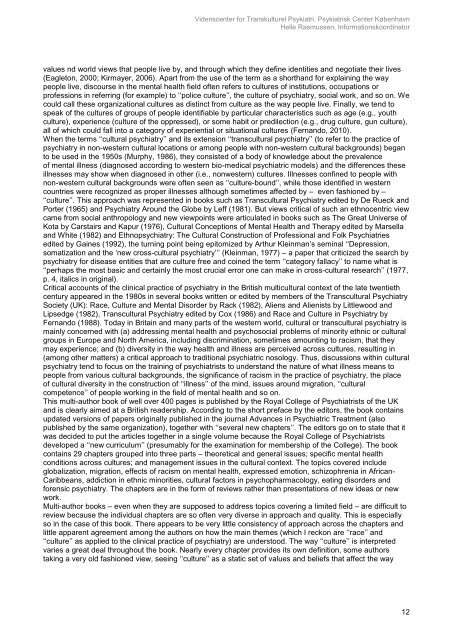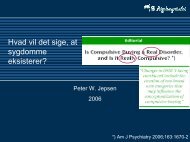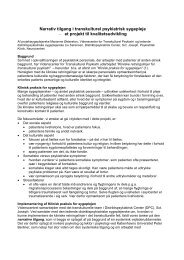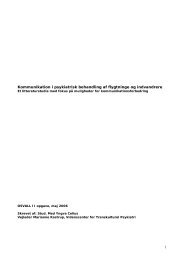Information om Transkulturel Psykiatri, marts 2009 - Videnscenter for ...
Information om Transkulturel Psykiatri, marts 2009 - Videnscenter for ...
Information om Transkulturel Psykiatri, marts 2009 - Videnscenter for ...
Create successful ePaper yourself
Turn your PDF publications into a flip-book with our unique Google optimized e-Paper software.
<strong>Videnscenter</strong> <strong>for</strong> <strong>Transkulturel</strong> <strong>Psykiatri</strong>. <strong>Psykiatri</strong>sk Center København<br />
Helle Rasmussen, <strong>In<strong>for</strong>mation</strong>skoordinator<br />
values nd world views that people live by, and through which they define identities and negotiate their lives<br />
(Eagleton, 2000; Kirmayer, 2006). Apart fr<strong>om</strong> the use of the term as a shorthand <strong>for</strong> explaining the way<br />
people live, discourse in the mental health field often refers to cultures of institutions, occupations or<br />
professions in referring (<strong>for</strong> example) to ‗‗police culture‘‘, the culture of psychiatry, social work, and so on. We<br />
could call these organizational cultures as distinct fr<strong>om</strong> culture as the way people live. Finally, we tend to<br />
speak of the cultures of groups of people identifiable by particular characteristics such as age (e.g., youth<br />
culture), experience (culture of the oppressed), or s<strong>om</strong>e habit or predilection (e.g., drug culture, gun culture),<br />
all of which could fall into a category of experiential or situational cultures (Fernando, 2010).<br />
When the terms ‗‗cultural psychiatry‘‘ and its extension ‗‗transcultural psychiatry‘‘ (to refer to the practice of<br />
psychiatry in non-western cultural locations or among people with non-western cultural backgrounds) began<br />
to be used in the 1950s (Murphy, 1986), they consisted of a body of knowledge about the prevalence<br />
of mental illness (diagnosed according to western bio-medical psychiatric models) and the differences these<br />
illnesses may show when diagnosed in other (i.e., nonwestern) cultures. Illnesses confined to people with<br />
non-western cultural backgrounds were often seen as ‗‗culture-bound‘‘, while those identified in western<br />
countries were recognized as proper illnesses although s<strong>om</strong>etimes affected by – even fashioned by –<br />
‗‗culture‘‘. This approach was represented in books such as Transcultural Psychiatry edited by De Rueck and<br />
Porter (1965) and Psychiatry Around the Globe by Leff (1981). But views critical of such an ethnocentric view<br />
came fr<strong>om</strong> social anthropology and new viewpoints were articulated in books such as The Great Universe of<br />
Kota by Carstairs and Kapur (1976), Cultural Conceptions of Mental Health and Therapy edited by Marsella<br />
and White (1982) and Ethnopsychiatry: The Cultural Construction of Professional and Folk Psychiatries<br />
edited by Gaines (1992), the turning point being epit<strong>om</strong>ized by Arthur Kleinman‘s seminal ‗‗Depression,<br />
s<strong>om</strong>atization and the ‗new cross-cultural psychiatry‘‘‘ (Kleinman, 1977) – a paper that criticized the search by<br />
psychiatry <strong>for</strong> disease entities that are culture free and coined the term ‗‗category fallacy‘‘ to name what is<br />
‗‗perhaps the most basic and certainly the most crucial error one can make in cross-cultural research‘‘ (1977,<br />
p. 4, italics in original).<br />
Critical accounts of the clinical practice of psychiatry in the British multicultural context of the late twentieth<br />
century appeared in the 1980s in several books written or edited by members of the Transcultural Psychiatry<br />
Society (UK): Race, Culture and Mental Disorder by Rack (1982), Aliens and Alienists by Littlewood and<br />
Lipsedge (1982), Transcultural Psychiatry edited by Cox (1986) and Race and Culture in Psychiatry by<br />
Fernando (1988). Today in Britain and many parts of the western world, cultural or transcultural psychiatry is<br />
mainly concerned with (a) addressing mental health and psychosocial problems of minority ethnic or cultural<br />
groups in Europe and North America, including discrimination, s<strong>om</strong>etimes amounting to racism, that they<br />
may experience; and (b) diversity in the way health and illness are perceived across cultures, resulting in<br />
(among other matters) a critical approach to traditional psychiatric nosology. Thus, discussions within cultural<br />
psychiatry tend to focus on the training of psychiatrists to understand the nature of what illness means to<br />
people fr<strong>om</strong> various cultural backgrounds, the significance of racism in the practice of psychiatry, the place<br />
of cultural diversity in the construction of ‗‗illness‘‘ of the mind, issues around migration, ‗‗cultural<br />
c<strong>om</strong>petence‘‘ of people working in the field of mental health and so on.<br />
This multi-author book of well over 400 pages is published by the Royal College of Psychiatrists of the UK<br />
and is clearly aimed at a British readership. According to the short preface by the editors, the book contains<br />
updated versions of papers originally published in the journal Advances in Psychiatric Treatment (also<br />
published by the same organization), together with ‗‗several new chapters‘‘. The editors go on to state that it<br />
was decided to put the articles together in a single volume because the Royal College of Psychiatrists<br />
developed a ‗‗new curriculum‘‘ (presumably <strong>for</strong> the examination <strong>for</strong> membership of the College). The book<br />
contains 29 chapters grouped into three parts – theoretical and general issues; specific mental health<br />
conditions across cultures; and management issues in the cultural context. The topics covered include<br />
globalization, migration, effects of racism on mental health, expressed emotion, schizophrenia in African-<br />
Caribbeans, addiction in ethnic minorities, cultural factors in psychopharmacology, eating disorders and<br />
<strong>for</strong>ensic psychiatry. The chapters are in the <strong>for</strong>m of reviews rather than presentations of new ideas or new<br />
work.<br />
Multi-author books – even when they are supposed to address topics covering a limited field – are difficult to<br />
review because the individual chapters are so often very diverse in approach and quality. This is especially<br />
so in the case of this book. There appears to be very little consistency of approach across the chapters and<br />
little apparent agreement among the authors on how the main themes (which I reckon are ‗‗race‘‘ and<br />
‗‗culture‘‘ as applied to the clinical practice of psychiatry) are understood. The way ‗‗culture‘‘ is interpreted<br />
varies a great deal throughout the book. Nearly every chapter provides its own definition, s<strong>om</strong>e authors<br />
taking a very old fashioned view, seeing ‗‗culture‘‘ as a static set of values and beliefs that affect the way<br />
12






